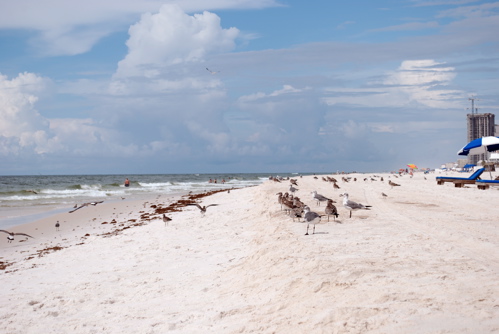
Wide shot of Orange Beach behind the Holiday Inn Express, August 19, 2010
Orange Beach, Alabama has been the subject of many questions, accusations and rumors regarding the presence of Corexit components, oil, and "cover-ups" regarding the safety of the area for residents and tourists alike. So, we took a drive and spent two days in the area, interviewing activists and city officials. We tried to converse with chemist Bob Naman of ACT Laboratory, but after numerous attempts to contact him regarding his well -publicized test results for Corexit compounds, including a visit to his lab on Pleasant Valley Road, and a phone call to his receptionist as we are writing this, we have had almost no luck.
However, a spontaneous visit to City Hall answered a lot of questions.
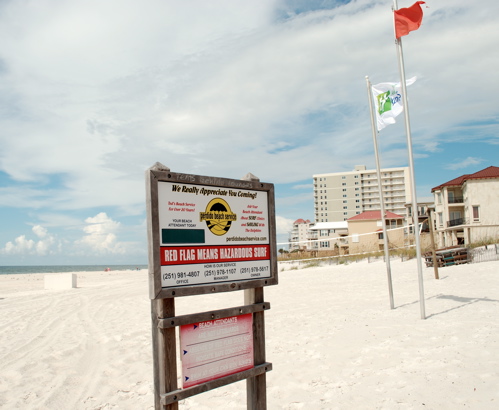
Red flag means no swimming
As we have written before, people along the Gulf are scared, confused, and in some cases angry that they have not gotten the straight story on air and water quality. There is no doubt that BP lied about the amount of oil being spewed into the Gulf of Mexico from Day One, no doubt that the EPA has obfuscated issues surrounding the use of the chemical dispersant, Corexit, and no doubt that bloggers have gone entirely beyond the tenets of responsible journalism. The Gulf of Mexico is neither an apocalyptic wasteland, nor was it a pristine body of water before the explosion of the Macondo wellhead in April.
Orange Beach is one community among hundreds along the Gulf Coast that have been affected by the release of almost 5 million barrels of oil into the ecosystem.
The morning of the first day was spent with a group of activists. There were many concerns and questions, as well as suggestions of cover-ups, but no one was able to step forward with names or contacts as verifications. This included our requests for hard copies of lab results for chemically induced illnesses. We took some video as testimony, spent some time digging on the beach for degraded oil; and it was easy to find within inches of the surface. The testimony is compelling, and I want to show that to readers in a future post. These people are scared and worried and deserve answers.
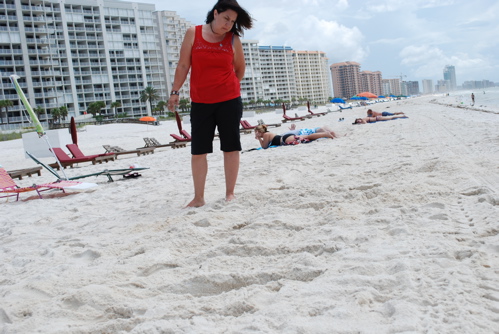
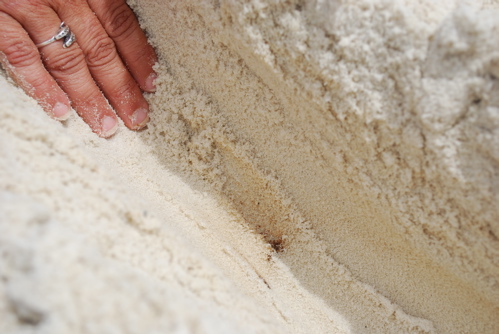 We did find evidence of oil in several shallow trenches
We did find evidence of oil in several shallow trenches
The latest news out of Orange Beach is that ACT Laboratory found a component of Corexit in Cotton Bayou. Actually, the "news" from TV station WKRG was that the "chemical dispersant Corexit" was found in Cotton Bayou. First off, there are several chemical components of Corexit and you cannot test for "Corexit" as such.
Reporter Debbie Williams said, "She (a resident) got samples and sent them to chemist Bob Naman in Mobile whose tests results show 13 point 3 parts per million of the chemical dispersant Corexit."
What was found, and it was found by "a lab in Ohio," according to Naman's receptionist, was 2-butoxyethanol, a component of the outlawed Corexit formulation EC9527A. Now we cannot confirm this, because Naman will not let us view the test results or contact the "lab in Ohio." We called him twice from the meeting with activists at the Holiday Inn Express and were told he was at a funeral and that he would call us back later in the afternoon. This was on Thursday.
On Friday, he still had not called, so we drove to his office and lab, which was locked at 8 AM. So we took a few photos to show we tried and were about to leave when his receptionist pulled up. We asked to come in and were allowed, but she did not seem too happy about it.
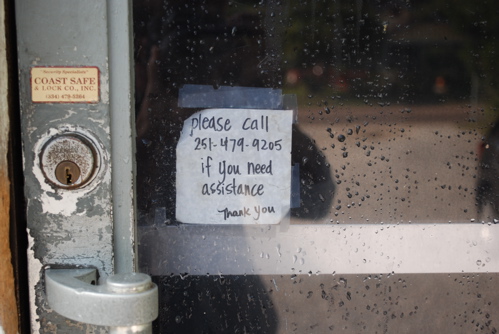
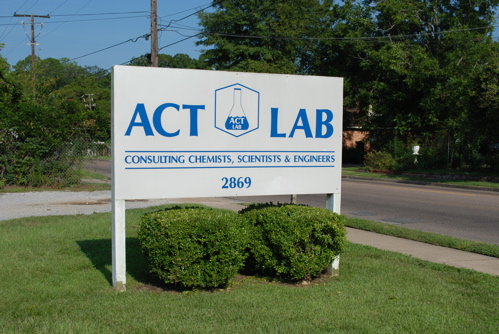
We asked for test results and certifications for the lab, but were told she could not supply them. We went out to our car to grab a camera and notepad and when we returned, the receptionist was in an agitated conversation on the phone with someone called, "Bob."
"I can't do that Bob, it would be helpful if you would talk with her."
We asked if "Bob" was Naman and she nodded in the affirmative.
We said, "It would indeed be very helpful if Dr. Naman would talk to us."
She repeated the same to "Bob," and the answer was that he would call us back later in the day. He did not. We tried again and again while writing this story.
Begging was the next option, and I did.
What we do know is that there are two possibilities for the 13.3 parts per million of "something." It can either be 2-butoxyethanol or propylene glycol, found in the Corexit formulation EC9527A (supposedly discontinued), or propylene glycol found in Corexit EC9500A.
If we accept the worst-case scenario offered by Naman's receptionist (with no supporting paperwork) that it was 2-butoxyethanol, how "toxic" is a concentration of 13.3 ppm?
The PEL (permissible exposure limit) for humans is 25 ppm, reduced from 50 ppm in an abundance of caution by regulatory agencies.
So taking the strictest guideline of a PEL of 25 ppm--that is a little less than twice what "the lab in Ohio" allegedly documented, you would have to be immersed in it daily for an average eight-hour workday--long-term exposure.
Hoping for some kind of documentation, we learned that ACT had done testing for a welding company, WELDCO. We looked up the address, programmed the GPS, took a drive to Hammock Road, and found a garage with welding tanks and a very nice gentleman petting his cat. WELDCO is classified as anything from "fabricated structural metal manufacturing" to "plate work manufacturing" on its company profile.
The gentleman said he did indeed have testing done by Naman's Lab and that it cost him almost $600 to have a test done for Corexit.
"Why were you testing?"
"The fish in my fish pond out back were dying."
"Did they find anything?"
"Oh they found Corexit."
"Well, Corexit is made up of several things. Did they find 2-butoxyethanol?"
"No. They found arsenic and a whole bunch of other stuff."
"Would you mind showing me the test results?"
"Don't have them. They are with my lawyer."
So, no luck on documentation at WELDCO either. I did look up the by products of welding, and it might explain what happened to the fish and spare WELDCO the costs of more testing, which the gentleman said he was going to do.
Welding "smoke" is a mixture of very fine particles (fumes) and gases. Many of the substances in welding smoke, such as chromium, nickel, arsenic, asbestos, manganese, silica, beryllium, cadmium, nitrogen oxides, phosgene, acrolein, fluorine compounds, carbon monoxide, cobalt, copper, lead, ozone, selenium, and zinc can be extremely toxic.
As I was writing this, Dr. Naman called me. I was hopeful.
The bottom line from Dr. Naman was, "You have no right to ask for any information from me; I am not a public company. You can't just walk into my lab and ask for information. Who do you work for?"
"I am an independent journalist."
"So, you don't know who you work for?"
This wasn't going anywhere, I thought. But he had a point. Independent journalists usually have no idea whom they are working for. I tried a different approach.
"What about the lab in Ohio that did the test. Can you give me the name?"
"You just can't break into anyone's private information. You need permission. You need the client's permission and you need my permission, but to tell you the truth, I won't allow it even if she (the client) gives her permission."
"So, you won't give me your certification information, either."
"No, good luck." (Click)
Dr. Naman (Bob) was either having a very bad day or thought I was one of the reports of "Thugs Threatening Independent Scientists" roaming the blogosphere.
I was also told that Bob said he was worried because BP had just called him and threatened him. I am not certain the reason or nature of the threats or whether they were financial or physical threats, but given the sudden rash of untimely deaths of those with damaging knowledge about BP I would not take any threats from BP lightly.Then there is the BP Contractor who was fatally hit by a car, heart attack suffered by a BP executive and Matt Simmons, two BP contractors who apparently committed suicide, and the mysterious plane crash that caused the death of Alaskan Senator Ted Stevens.
This effort at tracking down the story of Dr. Naman at the request of community activists was a complete bust and in stark contrast to my experience the previous afternoon. After the meeting at the Holiday Inn Express, I chanced a stop at City Hall with no appointment. I just "walked right in" and the receptionist said the Mayor would be in momentarily and happy to speak with me. He did and was.
So after a few minutes of conversation, while Mayor Tony Kennon waited for the City Engineer, Kit Alexander, to join us, we established that the city was willing to spend up to $100,000 in testing, that all of the current air and water test results are public, and that they had already found propylene glycol, a component of EC9500A in minute amounts (66 parts per million) in Cotton Bayou. However, it was of enough concern to city officials that the samples were being tested for a chemical marker that could link the chemical to the Corexit sprayed by BP. They had not found 2-butoxyethanol, the controversial component of the banned EC9527A.
The Mayor would continue to fly double red flags on the beaches until he was certain the waters were safe, and right now he could not offer that guarantee. Alexander said she was looking to establish "day care standards," for toxic monitoring.
So, I grabbed my video camera and spent some time with the Mayor and his Engineer. Take the time to listen critically to this. It is spontaneous and Alexander and Kennon had no idea I was showing up, camera in hand.
Here is what I learned.
There are many postings about air and water quality samplings at Orange Beach here.
At the risk of sounding like Anderson Cooper begging BP for an on camera interview, I would happily offer Dr. Naman the same opportunity to be interviewed. People are scared and want to hear from him.
